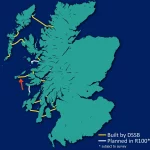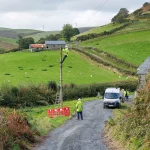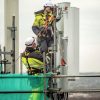EE Highlights New Approach to Help Improve UK 4G Mobile Coverage
Mobile operator EE has today announced the introduction of their new ‘Time on 4G‘ measure of customer network experience, which should help them to identify and upgrade parts of the United Kingdom where their coverage needs to improve.
Traditionally Mobile Network Operators’ (MNO) have preferred to measure their network reach by looking at population coverage, which produces big percentages (it’s easy enough for operators to claim 98%+ coverage of a population) but this can also be quite misleading because most people live in urban areas.
Last year EE decided to tackle this by introducing the new “Clear on Coverage” campaign, which adopted the much more reflective measure of geographic coverage (here). At present EE’s geographic (landmass) 4G network coverage of the UK is around 86% and they aim to reach 95% by the end of December 2020. Rival operators trail behind this.
Advertisement
Fast forward one year and EE has decided to build on their campaign by adopting an additional measure called Time on 4G. As you might expect from the name, this is a measure that shows the percentage of time a customer is connected to 4G. For example, the average ‘Time on 4G’ for an EE customer in an urban area, with 4G Calling enabled, is 96%. In some rural areas, that figure is 79%, falling to 70% for a customer that isn’t using 4G Calling.
Rail commuters were also found to have a lower than average ‘Time on 4G’ (hardly a surprise due to all the notspots along routes) and EE explained that this was part of the reason why they intend to invest “tens of millions of pounds on specific rail coverage upgrades in 2018 alone,” although other operators are also considering similar investments (e.g. on the TfL underground).
Overall EE said this approach “informs and validates predictive measures such as geographic coverage percentage.”
Marc Allera, EE CEO, said:
“Our industry has to get better at giving customers the information they need to make an informed choice about the mobile network that best suits their needs.
I banned misleading population coverage measurements at EE a year ago, and we’ve seen real change since then. The fundamentally misleading claim of ‘99% coverage’ is very hard to find on mobile operators’ websites today.
We are introducing new measurements today that will give us a more accurate view of our customers’ network experience than ever before. And we’re working with Ofcom to improve the quality of information that’s available to customers, as we share their ambition to improve transparency around network performance.”
In fairness, delivering strong geographic coverage is certainly a lot easier to do when you also happen to own over 40% of the available mobile spectrum and had a big head-start on the deployment of 4G services. EE were able to harness 1800MHz for 4G, while rivals O2, Three UK and Vodafone waited for the 800MHz and 2.6GHz spectrum release.
Advertisement
Meanwhile EE said they were also looking for the Government to move quickly on the pledges it made in the Autumn Budget to improve rail coverage, such as by incentivising mobile operators, train operating companies and rail land owners to work together and remove barriers to installing essential trackside sites.
NOTE: EE said that the data for their ‘Time on 4G’ measures is collected at an anonymised customer level.
Mark is a professional technology writer, IT consultant and computer engineer from Dorset (England), he also founded ISPreview in 1999 and enjoys analysing the latest telecoms and broadband developments. Find me on X (Twitter), Mastodon, Facebook, BlueSky, Threads.net and Linkedin.
« Government Consults on Changes to Soften UK Internet Snooping Law

















































Comments are closed